Bio14
DIVERSITY OF ORGANISMS
VIRUSES
-smallest living organisms, 20nm - 300nm, smaller than bacteria
-obligate parasites: live only in body of living hosts > harms host, not capable of reproducing outside host, host suffers > dies > parasite seeks new host (facultative parasite = parasite stays on dead host)
-very simple structures: small amount of genetic material, RNA/DNA, surrounded and protected by protein coat, capsid
-no cytoplasm, no cell organelles, no storage food substances
-pathogens, causes diseases in plants+ animals (influenza,small poxs,mumps,measles,poliomyelits,yellow fever,AIDS )
-1.plant viruses: RNA, 2.animal viruses: DNA, 3.bacterial viruses (bacteriophages): DNA
-reproduction: in body of living organisms, genetic material injected into body of host cell > DNA takes complete control of cell > prevents host cell from reproducing > DNA replicates into small pieces > proteins synthesise and cover DNA particles > complete units > host cell ruptures > viral particles escape
Role of Viruses
Biological controls: control pest population, targets specific organisms, not like chemical controls (myxomatosis-rabbits)
Pathogens: long-term immunity-antibodies produced, immunization-harmless form of virus > produce antibodies
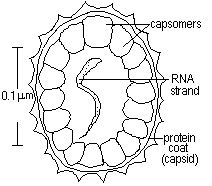


BACTERIA(anaerobic + aerobic)
average diameter-1mm, length 0.1 - 10mm
-smallest organisms having cellular structures
-unicellular organisms seem under microscope
-simple structure: protein coat encloses genetic material and covers cell wall, which is rigid. Cell wall prevents bact from swelling and bursting in hypotonic sol.
-mobile; flagellum-allows tactic movement
-cytoplasm contains ribosomes, pigments, glycogen granules, fat globules, etc. no mito but mesosomes for oxidation of food substances
-DNA: as a single circular molecule > scattered throughout cytoplasm (primitive characteristic of prokaryotes)
Nutrition: 1.heterotrophic-saprophytic + parasitic, 2.photoautotrophic-bacteria chlorophyll, 3.chemoautotrophic-chemicals
-heteroptrophic: lack chlorophyll > parasites-from living org or saprophytes-dead, decaying material
-reproduction: asexual- fast binary fission, sexually-conjugation
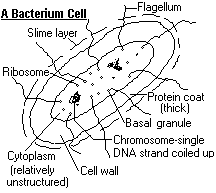
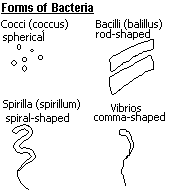
FUNGI(unicellular > larger multicellular)
-body structure consists of a mass of fine tubular thread-like structures, hyphae, forming a mycelium,. Each hypha: thin,strong cell wall of fungal cellulose + chitin, no cross walls > contain a mass of cytoplasm, many nuclei. cytoplasm - ribosomes, mito., glycogen granule, fat and oil globules, no starch
-lack chlorophyll > heterotrophs- saprophytic/ parasitic
saprophytic fungi: produce enzymes on hosts tissues > digest complex solid food substances > simple soluble, diffusable products > enter fungi by diffusion
parasitic fungi: attack plants + animals, hyphae penetrate hosts tissues > produce out-growths, haustoria which absorbs food directly form host cell
bact + fungi = decomposers
-asexually reproduction: spore formation- abundant food supply + conditions favourable > some hyphae grow vertically upwards > end in sporangia. sporangia produce spores. sporangium bursts > spores liberated > carried by wind > germinate > form new mycelium in suitable places
-sexually reproduction; conjugation, + & - strains of different hyphae fuse together > form zygote > new mycelium
INSECTS
-largest group of animals in animal kingdom, ~70% of all species
-only invertebrates that fly and survive to a large extent from water, widespread and adapted by all types of habitats
-most: herbivorous-plant material, large number: carnivorous-feed on animal tissue + tissue fluid, some parasitic + saprohytic
-most 2mm-40mm
General characteristics
-segmented body: head, thorax, abdomen
-exoskeleton/ cuticle of chitin covering entire body, protects from predetors, impermeable to H2O, prevents dessication
-jointed appendages
-2 pairs of wings-fore and hind wings attached to thorax
-short life span> abundant egg production
-metamorphosis: (in)complete- eggs > hatch > larvae > pupae > imago
-respiration-by tracheoles; branched trachea (direct contact w/ tissue: no transport sys.) opening to outside as spiracles
Helpful
-for cross pollination agents; attracted to flowers due to fragrant smell, nectar, pollen grains, bees-main pollinating agents, some flowers depend on insects > less pollen grains > less wastage compared to wind pollinated flowers
-biological control of pests-ladybirds eat aphids and many bugs, cactus moth caterpillars eat insects which invade agricultural land
Harmful
-food destroyers-locusts
-material destroyers-moths, termites
-disease vectors-mosquitoes > yellow fever virus, malaria protozoan, encephalitis , tsetse flies-human African sleeping sickness, houseflies- dysentery protozoan and bact, fleas (plague bact.)
-nuisances-cockroaches, ants- spoil food
ANGIOSPERMS
Leaf morphology
Dicotyledons
-reticulate venation (veins: net-like pattern)
-lamina (blade)(broad) and petiole (leaf stalk)
-dorso-ventral (dorsal and ventral surfaces differ)
Monocotyledons
-parallel venation (parallel veins)
-lanceolate (elongate)(narrow lamina)
-identical dorsal and ventral surfaces
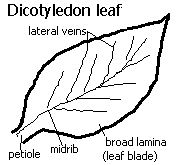
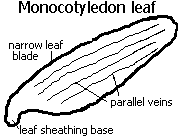
Stem anatomy + Root anatomy
Dicotyledons
stem: ring of vascular bundles
root: few groups of xylem, 2-8
-vascular cambium usually present > secondary growth
Monocotyledons
stem: vascular bundles scattered
root: many groups of xylem (up to 30)
-vascular cambium usually absent > no secondary growth (exceptions: palms)
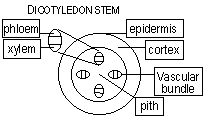



Root morphology
Dicotyledons
TAP ROOT SYSTEM; primary root as tap root that has lateral/ secondary roots
Monocotyledons
FIBROUS ROOT SYSTEM; adventitious roots from base of stem
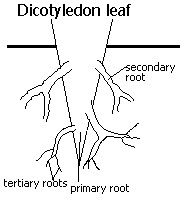
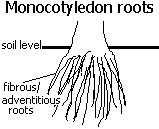
Seed morphology
Dicotyledons
embryo: 2 cotyledons
Monocotyledons
embryo: 1 cotyledon
Flowers
Dicotyledons
-parts in 4/5's
-perianth segments differ, forming calyx (sepals) and corolla (petals)
-often insect pollinated (bright petals)
Monocotyledons
-parts usually in 3's
-perianth segments identical, no distinct calyx and corolla
-often wind pollinated (dull petals)
Examples
Dicotyledons
-pea, rose, buttercup, dandelion
Monocotyledons
-grasses, iris, orchids, lilies
Importance of Angiosperms (flowering plants- dicotyledons + monocotyledons)
angiosperms: dominant terrestrial vegetation
-adapted to live on land (efficient water-carrying xylem vessels) and in water
-characteristic-flowers, pollinated by insects of wind, produce seeds enclosed by an ovary
-economically useful; monocot: cereals, grasses, eg wheat, oat, barley, padi, etc.
dicot: fruit rees, vegetable crops, broad-leaved forest trees (wood, drugs, fibres, etc)
-important primary producers, replenish oxygen in atmosphere
Nutrient cycles and Ecology
Parasitism
The Human Impact on the Environment
Reproduction in plants
Sexual reproduction in animals
Genetics
Cell Structure and Organisation
Enzymes
Nutrition
Transport in Plants
Support, Movement and Locomotion
Transport system in man-circulatory system
Respiration
Excretion
Homeostasis
The Eye
Nervous System
Chemical Control of Plant Growth
The Use and Abuse of Drugs
Back to 'O' level notes index
Back to notes index












